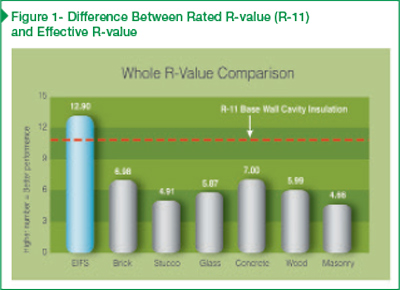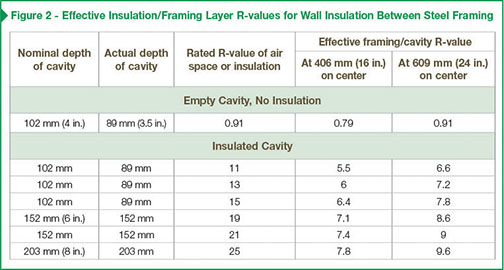Energy codes and continuous insulation

Data courtesy Oak Ridge National Library (ORNL)
Results of the study show a significant decrease between the rated and the effective R-values of the various walls using only cavity insulation. For example, Figure 1 shows although built on an R-11 assembly, the tested effective R-value of the brick veneer assembly was only R-6.98. This degradation of the perceived insulation value of the assembly is a direct result of thermal bridging. The study confirmed the dramatic negative effects of thermal bridging in assemblies that only use cavity insulation.
Tests such as ORNL’s are further substantiated by ASHRAE 90.1, specifically the standard’s Table A9.2B, which looks at the perceived versus the effective R-values of fiberglass batt insulation in steel-framed construction, and is used by mechanical engineers to determine the actual energy performance of exterior wall assemblies for the proper sizing of HVAC equipment.
The table in Figure 2 shows a perceived R-11 steel-framed wall assembly with studs at 406 mm (16 in.) on center (oc)—the underlying assembly used in the ORNL study walls—in reality has only the effective R-value of 5.5. This is a reduction of 50 percent from the rated value of its constituent insulation. Further, the ASHRAE table demonstrates the futility of attempting to overcome poor performance by increasing stud depth and quantity of cavity insulation. Moving from an R-13 to an R-19 with the perceived increase of R-6, in fact gains only an effective increase of R-1.1.

Data courtesy ASHRAE 90.1, Table A9.2B
Concrete masonry units (CMUs) are also widely used in structural exterior wall construction. CMU is a highly conductive (low R-value) material. Insulating CMU walls generally requires adding insulation in between furring channels, which are required for cladding attachment to the exterior, or the gypsum wallboard to the interior. However, the furring re-creates the repeating thermal breaks, again allowing heat flow to essentially bypass the insulated portions and does not meet the ASHRAE definition of continuous insulation.
As seen, cavity insulation alone provides little thermal benefit when undermined by thermal bridging. R-value reduction due to thermal bridging is not an indictment of cavity insulations. Even the most efficient insulation materials cannot function to their fullest potential when interrupted every 406 mm oc. The surest method of overcoming these energy-sapping hazards, now codified in IECC and ASHRAE 189.1, is the application of a layer of continuous insulation to the exterior wall.
Further issues
Dewpoint and related condensation is another critical issue in all modern wall assemblies. Dewpoint is defined as the temperature and pressure at which the humidity in moisture-laden air potentially condenses from vapor into liquid form. This gaseous moisture can travel from inside a heated building to a cold exterior in cold climates and/or from a hot exterior to a cooled interior in warmer climates. Condensation will occur when the moisture-laden air contacts surfaces that are below the dewpoint temperature.
It follows then, as required by the IECC, thermally isolating the wall by the addition of exterior continuous insulation will greatly improve the wall’s ability to tolerate moisture vapor. Since warmer air can hold more water in vapor form, by adding insulation on the exterior, the temperature of the wall is increased (for heating seasons), thereby reducing the possibility of condensation occurring within the structural portion of the assembly.
As stated, dewpoint is wall- and climate-dependent. Its potential can only be fully identified through some form of water vapor transmission analysis such as the German heat and moisture thermodynamics calculator, Wärme Und Feuchte Instationär (WUFI). Reputable manufacturers of insulation materials and thermal claddings will generally perform these calculations for the design and construction professional as a complimentary service.



